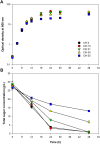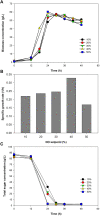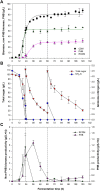High Cell Density Cultivation of Paracoccus sp. on Sugarcane Juice for Poly(3-hydroxybutyrate) Production
- PMID: 35646885
- PMCID: PMC9133739
- DOI: 10.3389/fbioe.2022.878688
High Cell Density Cultivation of Paracoccus sp. on Sugarcane Juice for Poly(3-hydroxybutyrate) Production
Abstract
High cell density cultivation is a promising approach to reduce capital and operating costs of poly (3-hydroxybutyrate) (PHB) production. To achieve high cell concentration, it is necessary that the cultivation conditions are adjusted and controlled to support the best growth of the PHB producer. In the present study, carbon to nitrogen (C/N) ratio of a sugarcane juice (SJ)-based medium, initial sugar concentration, and dissolved oxygen (DO) set point, were optimized for batch cultivation of Paracoccus sp. KKU01. A maximum biomass concentration of 55.5 g/L was attained using the C/N ratio of 10, initial sugar concentration of 100 g/L, and 20% DO set point. Fed-batch cultivation conducted under these optimum conditions, with two feedings of SJ-based medium, gave the final cell concentration of 87.9 g/L, with a PHB content, concentration, and yield of 36.2%, 32.1 g/L, and 0.13 g/g-sugar, respectively. A medium-based economic analysis showed that the economic yield of PHB on nutrients was 0.14. These results reveal the possibility of using SJ for high cell density cultivation of Paracoccus sp. KKU01 for PHB production. However, further optimization of the process is necessary to make it more efficient and cost-effective.
Keywords: bioplastic; high cell density cultivation; paracoccus sp.; process optimization; sugarcane.
Copyright © 2022 Moungprayoon, Lunprom, Reungsang and Salakkam.
Conflict of interest statement
The authors declare that the research was conducted in the absence of any commercial or financial relationships that could be construed as a potential conflict of interest.
Figures





Similar articles
-
Inexpensive fed-batch cultivation for high poly(3-hydroxybutyrate) production by a new isolate of Bacillus megaterium.J Biosci Bioeng. 2009 Mar;107(3):240-5. doi: 10.1016/j.jbiosc.2008.10.006. J Biosci Bioeng. 2009. PMID: 19269585
-
Biorefinery of sugarcane molasses for poly(3-hydroxybutyrate) fermentation and genomic elucidation of metabolic mechanism using Paracoccus sp. P2.Int J Biol Macromol. 2025 Apr;303:140684. doi: 10.1016/j.ijbiomac.2025.140684. Epub 2025 Feb 3. Int J Biol Macromol. 2025. PMID: 39909238
-
Biosynthesis of poly-3-hydroxybutyrate (PHB) from glycerol by Paracoccus denitrificans in a batch bioreactor: effect of process variables.Prep Biochem Biotechnol. 2015;45(1):69-83. doi: 10.1080/10826068.2014.887582. Prep Biochem Biotechnol. 2015. PMID: 24547951
-
Enhancing polyhydroxybutyrate production from high cell density fed-batch fermentation of Bacillus megaterium BA-019.Bioprocess Biosyst Eng. 2013 Oct;36(10):1463-74. doi: 10.1007/s00449-013-0885-7. Epub 2013 Jan 23. Bioprocess Biosyst Eng. 2013. PMID: 23340799
-
Production of poly(3-hydroxybutyrate) by high cell density fed-batch culture of Alcaligenes eutrophus with phospate limitation.Biotechnol Bioeng. 1997 Jul 5;55(1):28-32. doi: 10.1002/(SICI)1097-0290(19970705)55:1<28::AID-BIT4>3.0.CO;2-Z. Biotechnol Bioeng. 1997. PMID: 18636441
Cited by
-
Production of polyhydroxyalkanoates from renewable resources: a review on prospects, challenges and applications.Arch Microbiol. 2023 Apr 5;205(5):172. doi: 10.1007/s00203-023-03499-8. Arch Microbiol. 2023. PMID: 37017747 Review.
References
-
- Al-Battashi H., Annamalai N., Al-Kindi S., Nair A. S., Al-Bahry S., Verma J. P., et al. (2019). Production of Bioplastic (Poly-3-hydroxybutyrate) Using Waste Paper as a Feedstock: Optimization of Enzymatic Hydrolysis and Fermentation Employing Burkholderia Sacchari . J. Clean. Prod. 214, 236–247. 10.1016/j.jclepro.2018.12.239 - DOI
-
- Baird R. B., Eaton A. D., Rice E. W. (2017). Standard Methods for the Examination of Water and Wastewater. Washington, D.C.: American Public Health Association.
LinkOut - more resources
Full Text Sources
Molecular Biology Databases

